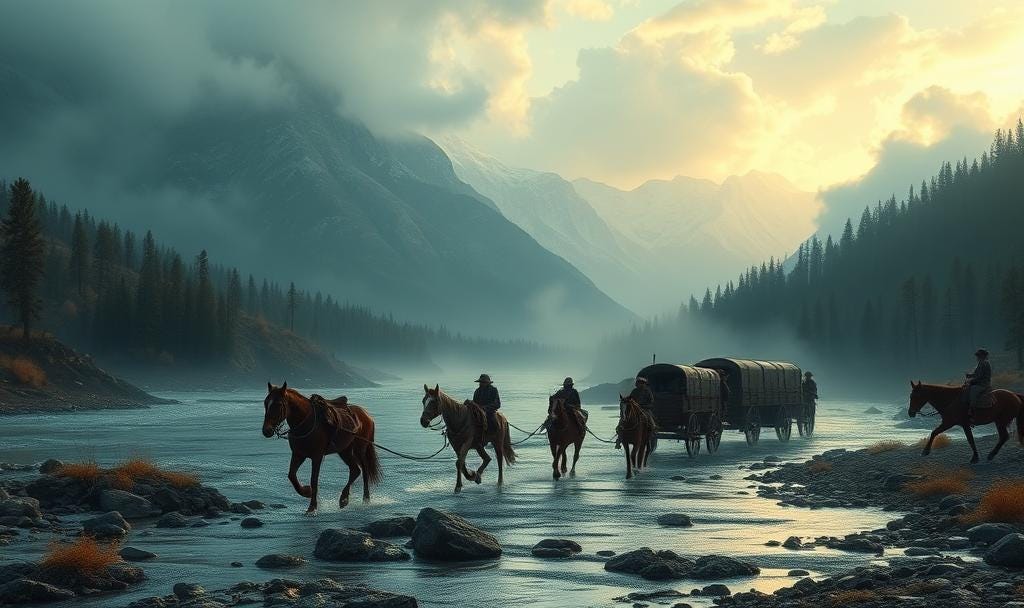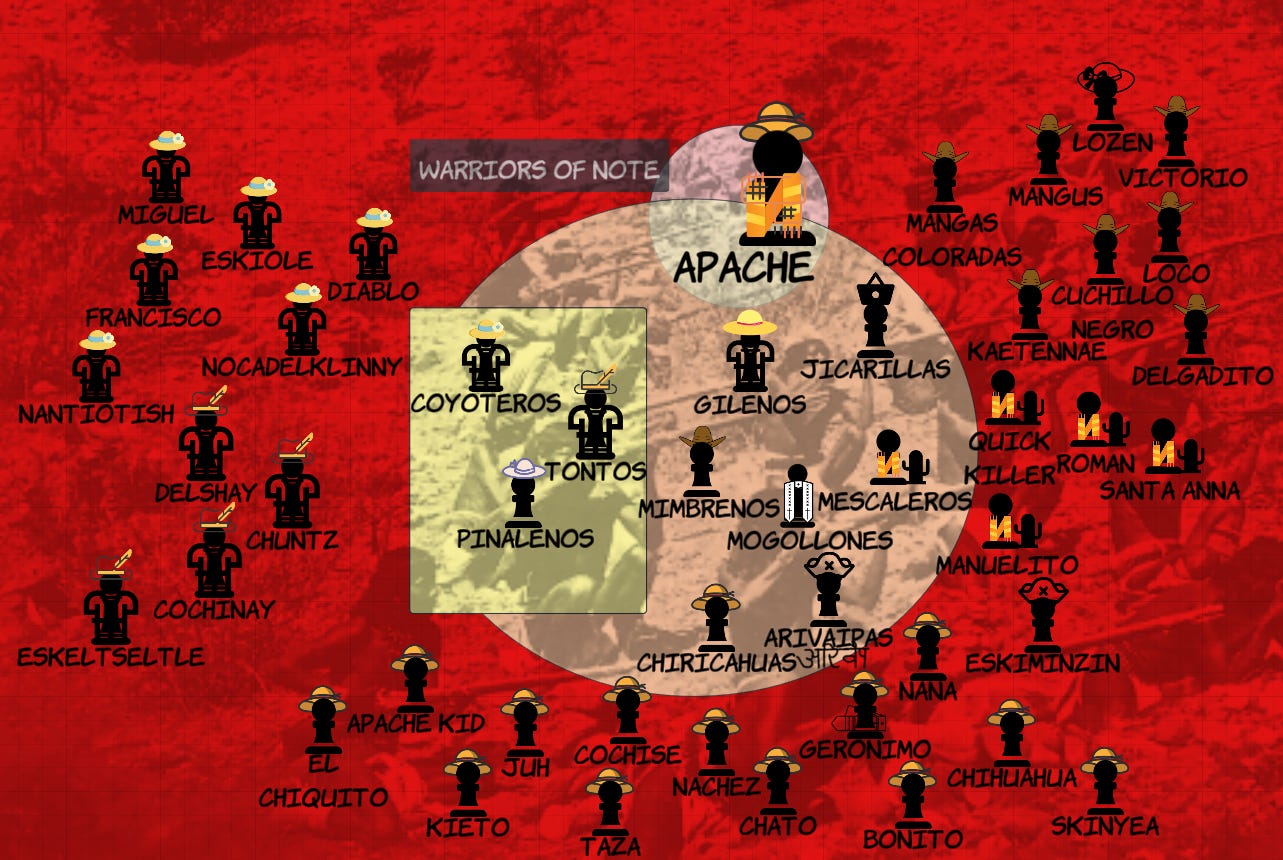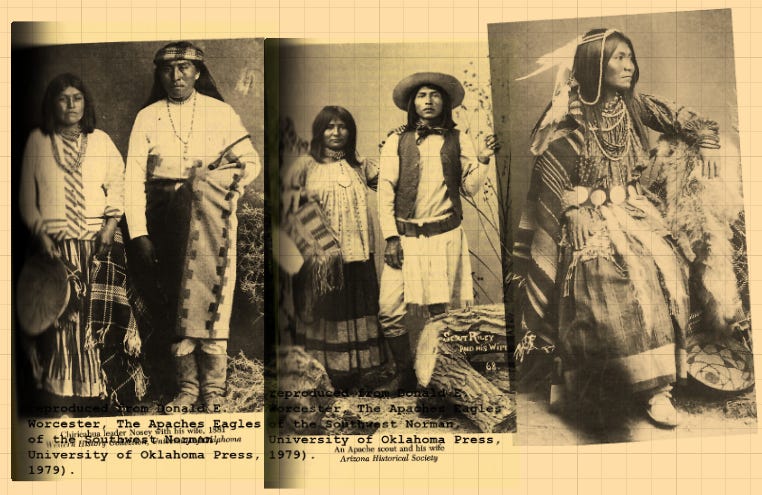Introduction
Apache refers to the Athapascan speaking peoples of the American southwest, in the present-day states of Arizona and New Mexico.
This series will explore the critical battles, wars and movements of Apacheria.
https://crackpot.substack.com/t/apacheria

The notion that there was a singular ‘Apache’ identity amongst all these peoples of the American southwest must be dispensed with at once by introduction. The Coyoteros, Tontos, Pinalenos, Gilenos, Mogollones, Minbrenos, Mescaleros, Jicarillas, and Chiracahuas are Apache bands. The western Apache are the Coyoteros, Tontos and Pinalenos.
Arizona New Mexico’s canyons, mountains deserts and rivers cut tripart relationships for any individual band. The Apache split east and west at about the border of Arizona and New Mexico.
After the Americans finally brought the Apache to capitulate to the reservation, the hardest challenge yet was how to re-constitute all these people on the reservations without touching off wars among the fierce rivalries that existed amongst them. Each band seemed friendly with at most one or two neighbors, and the rest were as fair game as the encroaching settlements of Mexico and Texas frontiers. For example, the Tontos and Chiracahuas were enemies.
Native Nation Context
Comancheria sat the east of Apacheria and the Sioux to the Northeast. To the south was Sonora, and other Mexican settlements. The Apache and Comanche seemed to especially dislike the Spanish and their colonial descendants.
The Kiowa Apache and Kiowa have an unfortunate name collision. The latter are stalwart allies of the Comanche after 1790. The Kiowa Apache are a different tribe from the Kiowa.
Plus Colonials

“Albert Franklin Banta told General Crook, ‘fight fire with fire.’ Crook was puzzled. Banta clarified, ‘Fight Apache with Apache.’
“Eskiminzin was certain there was no hope for peace with the Anglos. He said goodbye to Whitman, ‘The one who breaks the peace is to blame.’ On his way home, he visited his friend of many years, Charles McKinney, who had a farm near Fort Grant. They ate a meal and smoked together. When it was time to go, Eskiminzin drew a pistol and killed McKinney.” Later Eskiminzin explained the meaning of his action, ‘Any coward can kill his enemy. It takes a fierce man to kill his friend.’ - Worcestor. pg. 125
American forts peppered the landscape. The game was to live on one side and raid on the other - soldiers would have to stop at the border while Apache kept on going. Apache were surprised that the Americans wanted them to stop raiding Mexico - especially Sonora.
It is impossible to focus too much attention on the value of pack mules… without them successful pursuit of the elusive Apache bands would have been impossible. On the homespun side of the issue they were very much an integral part of the southwestern posts and provided a great deal of color to each military establishment, with continual coming and going from fort to fort, laden with field rations, and snaking out over the horizon in single file. - Smith pg. 131
Each mule knew not only its proper place in line but also its own pack gear, and a mule would simply refuse to move if another’s pack were placed on its back. Well-trained mules, when packed, fell into line behind the bell-mare (usually a white animal), while untrained mules wandered about and caused trouble. To identify troublemakers, packers shaved their tails. Trained mules were called ‘bell-sharp’; untrained mules were ‘shave-tails.’ So too green-horn second lieutenants were called shave-tails. - Worcester. pg. 125

Victorio relied heavily on his sister Lozen and old Nana. Lozen’s ‘power’ was in locating the enemy. When Victorio wanted to know in which direction the enemy was, she would stand with outstretched arms, palms up, praying to Ussen. She slowly turned, following the sun; her hands tingled and her palms changed color when they were pointed at the enemy. The intensity of the tingling in her hands indicated how near or far. … Lozen fought as ably as any warrior and too part in much of the fighting. She was the only woman invited to sit in council, for she was also a gifted strategist. - Worcestor pg. 218.
A small band call Arivaipas lived in Arivaipa Canyon, beside a creek that emptied into the San Pedro…. Although a small band, they were among the most active raiders. They were, man for man, the most destructive band in Arizona. Arivapas maintained close relations with Pinalenos.
Mangas Coloradas carried off a Mexican girl from a raid in Sonora, who, despite Apache opposition, became his wife. Mangas two Apache wives would not accept her as an equal. Their brothers challenged Mangas, who met them in Apache-style duels. When he had slain them both, there was nothing more for the Apache to say or do… Mangas’ Mexican wife bore him three beautiful daughters. Mangas arranged marriages for them with Chiricahua chief Cochise, with another Apache chief, and with a leading Navajo warrior. - Worcester. pg. 51.
Geronimo told them, “Tomorrow afternoon as we march along the north side of the mountains we will see a man standing on a hill to our left. He will howl to us and tell us the troops have captured our base camp.” In mid-afternoon the next day they heard a howl from a hilltop, and a warrior reported that the scouts with General Crook had captured the main camp. These were examples of Geronimo’s mysterious ability to know what was happening elsewhere. Jason Benitez was with him and witnessed it, but was never able to explain it. It was, however, one of Geronimo’s sources of power as a leader. - Worcester pg. 275
Nana, who as about 70 years old, still wanted peace, but he preferred to die fighting than return to San Carlos Reservation. He was a guerrilla leader of the same qualities as Victorio… Despite his age, no Apache had greater endurance than Nana. - Worcester pg. 232
Notes
References
Gwynne, S. C. (2010). Empire of the Summer Moon: Quanah Parker and the rise and fall of the Comanches, the most powerful Indian tribe in American history.
Cornelius C. Smith, Jr. Fort HuaChuca The story of a frontier post.
Thrapp, D. L. (1975). The conquest of Apacheria. University of Oklahoma Press.
Worcester, D. E. (1979). The Apaches Eagles of the Southwest. University of Oklahoma Press.
Melody, M. E. (1989). The Apaches. Chelsea House Publishers.








